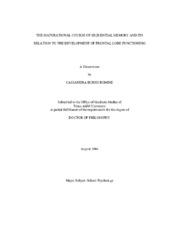| dc.description.abstract | The multidimensional nature of the frontal lobes serves to organize and coordinate brain functioning, playing a central and pervasive role in human cognition. The organizational and strategic nature of frontal lobe functioning affects memory processes by enhancing the organization of to-be-remembered information. Among the specific memory systems presumed to be based on anterior cerebral structures is the temporal organization of memory. An essential component of memory that involves temporal organization is sequential ordering. The acquisition of abilities thought to be mediated by the frontal lobes, including sequential memory, unfolds throughout childhood, serving to condition patterns of behavior for the rest of the brain. Development of the frontal regions of the brain is known to continue through late adolescence and into early adulthood, in contrast to the earlier maturation of other cortical regions.
The purpose of the present study was to evaluate the development of sequential memory and to compare such findings to what currently is known regarding the development of frontal lobe functioning. Through an analysis of the previously collected standardization data of the Test of Memory and Learning (TOMAL; Reynolds & Bigler, 1994), a developmental function depicting the maturational process of sequential memory was derived. This model was then compared to an overall representative model of frontal lobe functioning. Results indicated a staging of development that begins in early childhood with the maturation of sequential memory continuing, although at a decreased rate, into early adolescence. The greatest period of development in sequential memory was evident between 5 and 8 years of age. The rate of development then decreased, and a continued deceleration of maturation continued throughout the age span examined. Gender was not found to be a significant predictor of developmental performance on sequential memory tasks. The results of the present study are consistent with previous findings that have suggested that the development of frontal functions occurs in a step-wise fashion with greatest period of development in frontal lobe functioning occurring at the 6- and 8-year old levels, with more moderate effects between the ages of 9 and 12 and performance approximating adult levels during adolescence. | en |


